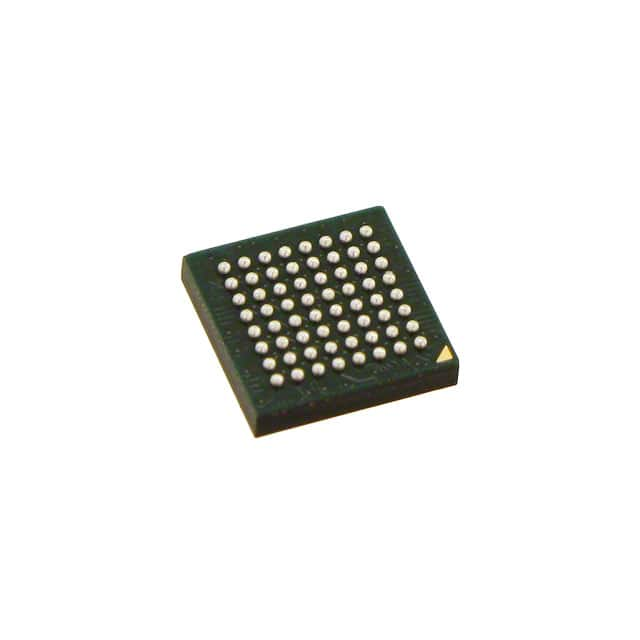Consulte las especificaciones para obtener detalles del producto.

MKL33Z128VMP4
Product Overview
- Category: Microcontroller
- Use: Embedded systems, Internet of Things (IoT) devices
- Characteristics: Low-power, high-performance, integrated peripherals
- Package: VMP4 package
- Essence: ARM Cortex-M0+ core microcontroller
- Packaging/Quantity: Individual units
Specifications
- Microcontroller Core: ARM Cortex-M0+
- Operating Frequency: Up to 48 MHz
- Flash Memory: 128 KB
- RAM: 32 KB
- Input/Output Pins: 51
- Analog-to-Digital Converter (ADC): 12-bit, 16 channels
- Serial Communication Interfaces: UART, SPI, I2C
- Timers: 4-channel TPM, 2-channel PIT
- Operating Voltage: 1.71V to 3.6V
- Operating Temperature Range: -40°C to +105°C
Detailed Pin Configuration
The MKL33Z128VMP4 microcontroller has a total of 51 input/output pins. These pins are used for various purposes such as general-purpose input/output (GPIO), analog input, serial communication, and control signals. The pin configuration is as follows:
- GPIO Pins: PTA0-PTA19, PTB0-PTB7, PTC0-PTC7, PTD0-PTD7, PTE0-PTE31
- Analog Input Pins: ADC0DP0-ADC0DP15
- Serial Communication Pins: UART0RX, UART0TX, SPI0SCK, SPI0MOSI, SPI0MISO, I2C0SCL, I2C0_SDA
- Control Pins: RESETb, NMIb, SWDCLK, SWDDIO
Functional Features
- Low Power Consumption: The MKL33Z128VMP4 microcontroller is designed to operate efficiently in low-power applications, making it suitable for battery-powered devices and energy-conscious systems.
- High Performance: With its ARM Cortex-M0+ core running at up to 48 MHz, the microcontroller offers fast processing capabilities for real-time applications.
- Integrated Peripherals: The microcontroller includes a variety of integrated peripherals such as ADC, UART, SPI, and I2C, enabling easy interfacing with external sensors, displays, and communication modules.
- Flexible Input/Output Configuration: The large number of GPIO pins allows for versatile input/output configurations, accommodating various application requirements.
- Wide Operating Voltage Range: The microcontroller can operate within a wide voltage range of 1.71V to 3.6V, providing flexibility in different power supply scenarios.
Advantages and Disadvantages
Advantages: - Low power consumption enables energy-efficient designs. - High-performance ARM Cortex-M0+ core ensures efficient execution of tasks. - Integrated peripherals simplify system design and reduce external component count. - Flexible input/output configuration allows for versatile application development. - Wide operating voltage range provides compatibility with different power sources.
Disadvantages: - Limited flash memory and RAM capacity may restrict the complexity of applications that can be implemented. - Lack of advanced features found in higher-end microcontrollers may limit certain application possibilities. - Availability and pricing may vary depending on the region and supplier.
Working Principles
The MKL33Z128VMP4 microcontroller operates based on the ARM Cortex-M0+ core architecture. It executes instructions stored in its flash memory and utilizes its integrated peripherals to interact with external components. The microcontroller's working principles involve receiving inputs from sensors or user interfaces, processing data, and generating appropriate outputs. It can perform tasks such as data acquisition, signal processing, communication, and control, making it suitable for a wide range of applications.
Detailed Application Field Plans
The MKL33Z128VMP4 microcontroller finds applications in various fields, including but not limited to:
- Internet of Things (IoT): The microcontroller's low-power characteristics and integrated peripherals make it ideal for IoT devices that require efficient communication, sensor interfacing, and control capabilities.
- Home Automation: With its flexible input/output configuration and communication interfaces, the microcontroller can be used in home automation systems to control lighting, temperature, security, and other household appliances.
- Industrial Automation: The microcontroller's high-performance core and integrated peripherals enable it to handle real-time control tasks in industrial automation systems, such as motor control, process monitoring, and data logging.
- Wearable Devices: Due to its low power consumption and small form factor, the microcontroller can be utilized in wearable devices like fitness trackers, smartwatches, and healthcare monitoring devices.
- Smart Agriculture: The microcontroller's ability to
Enumere 10 preguntas y respuestas comunes relacionadas con la aplicación de MKL33Z128VMP4 en soluciones técnicas
Sure! Here are 10 common questions and answers related to the application of MKL33Z128VMP4 in technical solutions:
Q: What is MKL33Z128VMP4? A: MKL33Z128VMP4 is a microcontroller based on the ARM Cortex-M0+ core, manufactured by NXP Semiconductors.
Q: What are the key features of MKL33Z128VMP4? A: Some key features include 128KB flash memory, 32KB RAM, 48MHz CPU clock speed, multiple communication interfaces (UART, SPI, I2C), and analog peripherals.
Q: What are the typical applications of MKL33Z128VMP4? A: MKL33Z128VMP4 is commonly used in various embedded systems, IoT devices, consumer electronics, industrial automation, and automotive applications.
Q: How can I program MKL33Z128VMP4? A: MKL33Z128VMP4 can be programmed using various development tools such as IDEs (Integrated Development Environments) like MCUXpresso, Keil, or IAR Embedded Workbench.
Q: What programming languages can be used with MKL33Z128VMP4? A: MKL33Z128VMP4 can be programmed using C or C++ programming languages, which are commonly used for embedded systems development.
Q: Can I use MKL33Z128VMP4 for real-time applications? A: Yes, MKL33Z128VMP4 is suitable for real-time applications due to its fast CPU clock speed and interrupt handling capabilities.
Q: Does MKL33Z128VMP4 support low-power modes? A: Yes, MKL33Z128VMP4 supports various low-power modes such as sleep, deep sleep, and stop modes, which are useful for power-constrained applications.
Q: Can I interface MKL33Z128VMP4 with external sensors or peripherals? A: Yes, MKL33Z128VMP4 has multiple GPIO pins, analog-to-digital converters (ADCs), and communication interfaces that allow easy interfacing with external sensors and peripherals.
Q: Is there any development board available for MKL33Z128VMP4? A: Yes, NXP provides development boards like FRDM-KL33Z, which are specifically designed for prototyping and evaluating the capabilities of MKL33Z128VMP4.
Q: Where can I find documentation and resources for MKL33Z128VMP4? A: You can find documentation, datasheets, application notes, and software libraries on the official NXP website or community forums dedicated to NXP microcontrollers.
Please note that these answers are general and may vary depending on specific use cases and requirements.

